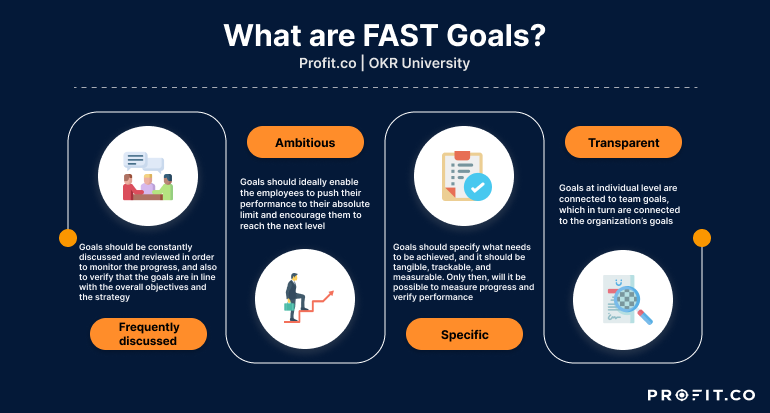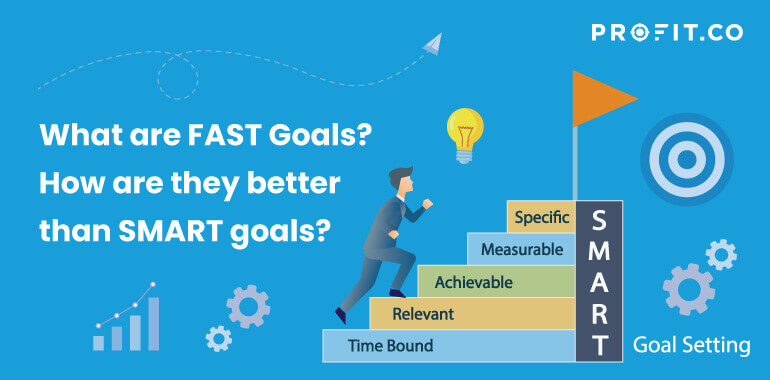Each and every business has a core vision or mission that articulates what the business aims to do in the long run. Vision is a reflection of the organization’s aspirations, and an organization sets its objectives and goals in line with that vision. Therefore, goal-setting is an integral part of an organization, its culture, and its strategy execution.
If what you are doing is not moving you towards your goals, then it’s moving you away from your goals.
Goals and their types

In order to make tangible, measurable gains, goals should be flexible, clearly-defined and easy to track and measure. The traditional management practice involves setting SMART goals. This is gradually being replaced by FAST goal setting. In order to understand why FAST goals are preferred, it is crucial to know how these goals work and what their advantages and disadvantages are.
What are SMART goals?
‘SMART goal’ stands for Specific, Measurable, Achievable, Relevant and Time-bound goal.
Specific: The goal should have a specific numerical target. For instance, the goal of an ambitious digital marketing initiative to increase brand visibility to twice the current amount in a month may involve:
- Posting a new social media ad once a week and achieving 5000 clicks for every such post
- Reaching 4000 followers for the brand account on social media by the end of the month, provided the brand already has 2000 followers
Measurable: The goal should be measurable so that the managers can track progress. For the above mentioned example, it is possible to track how many new followers the brand has gained on social media and how many people have viewed company ads in a specific time period. It may also show other insights such as the geographical location and the demographics of those who follow the brand on social media. This enables managers to verify if the goals have been achieved or not and decide a future course of action.
Achievable: If the goals are too high for employees to achieve, they will not be able to complete the goals on time. Additionally, goals that are too ambitious can lead to loss of motivation. At the same time the goal should not be too easy to achieve; otherwise, it will pave way for low performance. There should be a fine balance between ambitious and achievable goals.
Relevant: Goals should always be in line with the objectives of the organization. If they are not relevant, the activities of the employees and teams won’t lead to the desired outcomes and the fulfillment of organization objectives.
Time-bound: Every task, target and goal requires a specific amount of time to complete; if a goal is achieved after the specified deadline, it may not create the same impact and may even be deemed a failure. For instance, a delay in the release of your revolutionary product may allow your competitor to introduce a similar product and hijack your success story. So the goals should have reasonable deadlines, and they should be achieved within that. Goals need to be time-bound in order to be effective.
Disadvantages of SMART Goals
While SMART goals are proven and have been adopted as the standard in goal-setting, they have certain disadvantages:
1. When SMART goals are set by the employees, they might want to underestimate their abilities and capacity for achievement, meaning they set a lower target they know they can achieve. This may lead to underachievement.
2. When employees set SMART goals, they are driven by self-motivation to beat the benchmarks, which implies they may want to keep their goals private so that others do not know how high they aim. This may lead to lack of transparency. As a result, if they are not aligned to the objectives and the strategy, it may be impossible to know before it is too late.
3. While the spirit of goal-setting has to be inclined towards collective outcomes, SMART goals that lack transparency may be set towards highlighting individual performance. This will affect teamwork and coordination.
4. This lack of transparency, and the subsequent inability to identify issues and correct them on time can prevent your organization from being agile and responding to external challenges quickly. This can slow down the organization significantly and lead to failures.
These disadvantages call for making changes to the nature of the goals. FAST goals came into existence to address these disadvantages and optimize the goal-setting process.
Profit.co can help you transparently set and track goals. You can get started on Profit.co for free today!
What are FAST goals?
FAST goals stand for Frequently discussed, Ambitious, Specific and Transparent goals.

1. Frequently discussed
The goals should be constantly discussed and reviewed in order to monitor progress and also to verify that the goals are in line with the overall objectives and the strategy. Frequent discussions are indispensable in order to identify misalignment early during the progress and address them in a timely manner.
When the goals are constantly discussed by the teams and individuals with managers, it creates a culture of transparency with regard to what everyone in the team is up to and what they are planning to achieve. This gives an opportunity to identify areas of collaboration and better teamwork.
Frequent discussion of goals also pave way for healthy feedback and constant improvement. Discussions bring out how the work of every employee and outcomes they produce contribute to the objectives and the success of the organization. It makes them understand their importance in the organization and be accountable for the outcomes they produce.
In addition to these, frequent discussions of goals and the progress against objectives play a crucial role in identifying key areas of allocation and reallocation of resources. If there is a shortfall of resources in a particular area of great importance, discussions can help the managers transfer resources from lower priority areas. This is crucial for keeping the organization agile and adaptable to changing conditions.
2. Ambitious
The goals should ideally enable the employees to push their performance to their absolute limit and encourage them to reach the next level. So, the goals have to be ambitious in nature. They should be achievable, but hard to achieve at the same time.
Performance is a relative term, and employers are always compared against their colleagues. Ambitious goals promote a healthy competition amongst themselves to see how far they can push performance and outperform others.
Ambitious goals inspire employees to break the status quo, innovate, and find clever workarounds to the challenges at work everyday, in order to improve their performance every single time they set out to achieve a goal.
Ambitious goals inculcate a culture of performance and overachievement in the organization and prevent underperformance at every single level across the organization, as the employees have to always set the targets higher than before.
3. Specific
The goals should specify what needs to be achieved, and it should be tangible, trackable and measurable. Only then is it possible to measure progress and verify performance.
The goals get clearer and more measurable as they become more and more specific. For instance, if the goal is to improve the profitability of the organization, it may specify the expected rate of increase in profits; it can have a time span within which the target may need to be reached; it may also include the number of new orders and the value of new orders the company needs to achieve to reach the target; the goal may also specify the number of new units that need to be produced compared to the previous period of evaluation. Adding such parameters improves the ability to track this goal and measure progress using these metrics.
4. Transparent
Goals at the individual level are connected to team goals, which in turn are connected to the organization’s goals. The achievements of goals by individuals and their teams are the fundamental building blocks of success. Transparent goals make it possible for the leaders and management to verify the progress against objectives and ensure alignment to strategy.
Transparent goals also help managers identify lack of teamwork and cohesiveness amongst teams and within teams. This paves way for better coordination amongst individuals within teams and cross-functional teams.
As transparency of goals ensures alignment and teamwork, it helps the organization to remain agile and adaptable. When the goals are transparent, it promotes a healthy competition, as the employees can compare and benchmark their targets and achievements with their peers. This will help them push their performance further and contribute to the organization in a better way.
OKR and FAST Goals
OKR – a goal-setting framework for high-performance organizations
Objectives and key results (OKR) is a goal setting framework that enables employees to set goals and achieve them in order to contribute towards the overall objectives of the organization. By aligning the workforce towards the singular purpose of achieving the organizational objectives, OKR builds coordination and teamwork, and places emphasis on collective outcomes rather than individual achievements and activities. By enabling transparency and self motivation, it enables employees to set their own ambitious goals in line with the team goals, which in turn contribute to the overall objectives of the organization. OKR enables dreaming big and achieving more at every level of the organization.
In OKR, every ambitious, qualitative objective is accompanied by certain quantitative key results that enable the managers to constantly measure and track the progress for individual, team, and organizational goals periodically.
FAST goals
FAST goals are an emerging type of goal-setting technique, while Objectives and key results (OKR) are a proven goal-setting framework. When combined, these tactics can yield amazing results in your organization. OKRs and FAST goals can enhance the ability of an organization and its workforce to overachieve every time by setting specific, ambitious goals and discussing and reviewing them continuously in a transparent manner. By implementing FAST goals using OKR, the organization can quickly reach its objectives with organization-wide contribution from perfectly aligned individuals and teams, and remain agile and constantly adjusting to the changing conditions.
To learn how Profit.co can help you set and track your goals, book a free demo with our OKR experts today!
Ready to start your OKR Journey for FREE?
Frequently Asked Questions
Q1. Who created FAST goals?
FAST goals were introduced by Peter Drucker in 1954 as a part of the principle of Management By Objectives (MBO).
Q2. What are clear goals?
Clear goals are small actionable steps that were broken down from long-term goals. Upon completion, a clear goal will let you pursue the next short-term goal in the pipeline of the long journey, while giving you a sense of accomplishment and motivation.
Q3. What is the difference between FAST and SMART?
SMART goals by nature push employees towards individual performance and keeping their respective goals and targets private, while FAST goals promote transparency and teamwork.

